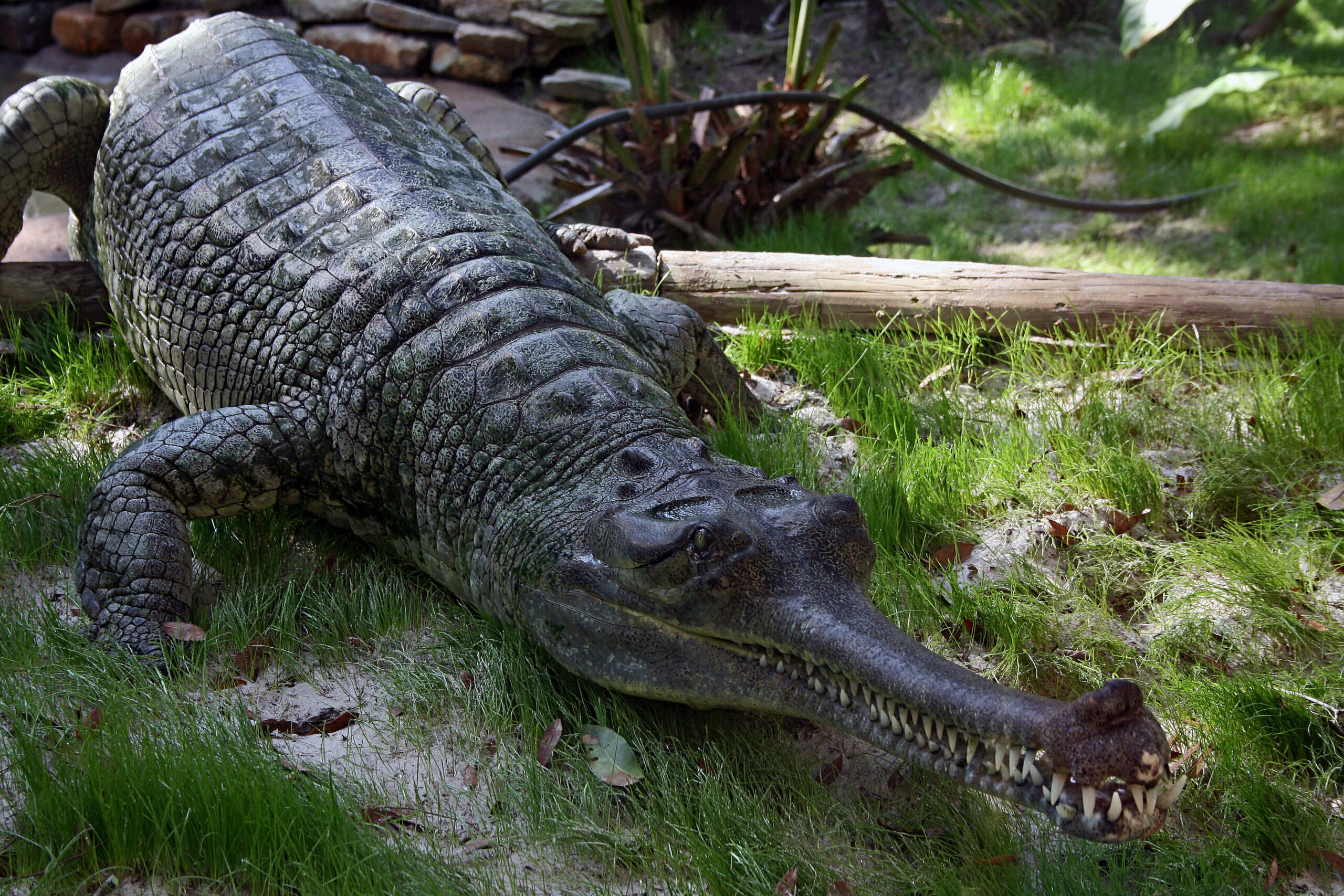The gharial (Gavialis gangeticus) is one of the most unique and critically endangered crocodilian species. Recognized by its long, slender snout and sharp teeth, this species once thrived in the rivers of the Indian subcontinent. However, due to habitat loss, pollution, and human activities, its population has declined dramatically, with fewer than 900 individuals remaining in the wild.

This article explores the physical characteristics, habitat, diet, behavior, threats, and conservation efforts surrounding the gharial.
Physical Characteristics
Gharials possess several distinctive features that set them apart from other crocodilians:
- Size: Males can reach up to 6 meters (20 feet) in length, while females are generally smaller, averaging around 4 meters (13 feet).
- Weight: They can weigh between 160 to 250 kilograms (350 to 550 pounds).
- Snout: The elongated, narrow snout is adapted for catching fish and minimizes water resistance while hunting.
- Gharas: Males develop a bulbous growth called a ghara at the tip of their snouts, which is used for vocalization and mating displays.
- Coloration: They typically have olive-green skin with darker markings, allowing them to blend into their freshwater environments.
Habitat and Distribution
Gharials are primarily found in the slow-moving freshwater rivers of northern India and Nepal. Historically, they occupied a vast range across the Indian subcontinent, including Bangladesh, Bhutan, and Pakistan. Today, their distribution is highly fragmented, with populations concentrated in a few key locations:
- Chambal River (India) – One of the last strongholds for gharials, providing essential breeding grounds.
- Ghagra and Gandak Rivers (India and Nepal) – Home to smaller but significant populations.
- Rapti and Narayani Rivers (Nepal) – Crucial for conservation programs.
Unlike other crocodilians, gharials are not well-adapted to terrestrial movement and rarely leave the water except for basking and nesting.
Diet and Feeding Behavior
Gharials are specialized piscivores, meaning they primarily consume fish. Their long, narrow snouts and interlocking, razor-sharp teeth allow them to catch slippery prey with minimal effort. Their feeding strategy includes:
- Quick sideways jaw movement to catch fish efficiently.
- Minimal resistance in water due to their streamlined skull structure.
- Occasional consumption of crustaceans and small amphibians, though fish remains their primary diet.
Unlike other crocodilian species, gharials pose no significant threat to humans as they do not prey on large mammals.
Behavior and Reproduction
Gharials exhibit fascinating social and reproductive behaviors:
- Basking in groups along riverbanks to regulate body temperature.
- Males using their ghara to produce underwater sounds that attract females during the breeding season.
- Nesting in sandy riverbanks, where females lay 30–50 eggs per clutch.
- Parental care, with mothers guarding the nests until hatchlings emerge, although they do not transport young in their mouths like other crocodilians.
Threats to Survival
Despite their unique adaptations, gharials face numerous challenges that have led to their critically endangered status:
1. Habitat Destruction
- Dams and irrigation projects alter river flow and reduce breeding grounds.
- Sand mining disrupts nesting sites, leading to low reproductive success.
- Pollution from industrial waste and pesticides affects their food supply and overall health.
2. Fishing Practices
- Accidental entanglement in fishing nets leads to injury or drowning.
- Overfishing depletes their primary food source, making survival harder.
3. Human Encroachment
- Expansion of agriculture and settlements reduces their natural habitat.
- Poaching for skins and traditional medicine has historically contributed to population declines.
- Cultural conflicts, where gharials are mistakenly seen as dangerous to livestock and humans.
4. Climate Change
- Rising temperatures affect nesting success by skewing gender ratios, as higher temperatures result in more males hatching.
- Altered river flow patterns impact breeding and feeding behavior.
Conservation Efforts
Recognizing the gharial’s dire situation, governments and conservation organizations have implemented various initiatives to protect and restore their populations.
1. Protected Reserves and Sanctuaries
Key conservation areas have been established to protect remaining gharial populations:
- National Chambal Sanctuary (India) – A stronghold for gharials, with dedicated conservation programs.
- Katerniaghat Wildlife Sanctuary (India) – A critical habitat with ongoing monitoring efforts.
- Chitwan National Park (Nepal) – One of the most important conservation sites for gharials in Nepal.
2. Captive Breeding and Reintroduction Programs
- Breeding programs in India and Nepal raise hatchlings in captivity before releasing them into the wild to improve survival rates.
- Artificial incubation of eggs increases hatching success by protecting them from natural threats.
- Regular population monitoring helps track their survival and adaptation to natural habitats.
3. Community Involvement and Awareness Campaigns
- Educating local communities about gharial conservation through workshops and ecotourism.
- Encouraging sustainable fishing practices to minimize accidental gharial deaths.
- Engaging villagers in habitat protection projects, such as reforestation of riverbanks.
4. Legislative Measures and Anti-Poaching Efforts
- Strict legal protections in India and Nepal prohibit gharial hunting and trade.
- Increased patrolling in protected areas reduces poaching and illegal fishing activities.
Future Prospects and Challenges
Despite conservation efforts, challenges remain in securing a stable future for gharials. Continued threats like habitat fragmentation, human-wildlife conflict, and climate change require sustained action. Future priorities include:
- Enhancing habitat connectivity between fragmented populations.
- Strengthening transboundary conservation efforts between India and Nepal.
- Utilizing advanced tracking technologies for better monitoring and research.
- Expanding community-led conservation programs to ensure long-term success.
Conclusion
The gharial is an extraordinary reptile that plays a crucial role in maintaining river ecosystems. With fewer than 900 individuals remaining, immediate and sustained conservation actions are essential to prevent further decline. By protecting their habitats, reducing human-induced threats, and fostering community involvement, there is hope that these remarkable crocodilians can recover and thrive in the wild for generations to come.





























